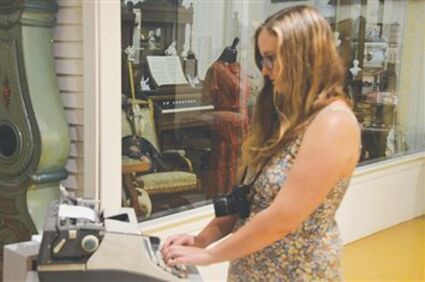Typewriters: Once essential tools of the trade
June 28, 2022
The nightmare scenario for reporters today is watching a nearly completed article vanish from the computer screen, lost in the grasp of cyberspace.
Nearly as dire is not receiving time sensitive responses to emailed interview questions, again because the electronic gods chose to defy the sanctity of deadlines.
Neither, however, was an issue back in the day, as the kids say.
That’s because newspaper composition – as were most writing tasks throughout the business world – was done on typewriters.
Manual typewriters were the staple of the old Channel Town Press office on Morris Street until the mid-1980s when the late Alan Pentz purchased Commodore 64 “home computers” and somehow aligned them with an Apple Macintosh that could read copy off floppy disks and format stories in columns.
But that’s a story for another time.
Using a typewriter, keystroking words onto actual paper, meant there was no “losing” stories to the technology netherworld.
Still, there were issues.
As with any device having multiple moving parts, things could go haywire at a moment’s notice. Keys would jam. Ribbons faded, frayed and tore.
Cutting and pasting meant just that. You would take scissors to cut the copy paper between those paragraphs where the inserted sentences were to be attached with scotch tape.
Spelling corrections were made by typing “xes” (xxxxxxx) through the mis-struck words. There was a newsroom code of symbols that could be penciled onto copy paper following composition to indicate the start of new paragraphs, letters needing capitalization and words whose order in a sentence required rearranging to assure proper grammar.
The entire process – especially for those unable to touch type – was much slower than today’s electronic standards and especially stressful when writing on deadline.
I had the good fortune of taking a typing class at La Conner High School from Gene Fowler, a teacher and Vietnam War vet who stressed the importance of learning the home row keys. He repeatedly drilled the class and held regular timed tests. Those who clung to the hunt-and-peck method – including Tim Dunlap, who would later master the typewriter and write entertaining horse racing columns for CTP – always scrambled to punch a few more keys after Fowler clicked his stopwatch.
Fowler also stressed the importance of maintaining proper posture at the keyboard and to not pound its keys. Today’s occasional backaches are evidence that lesson was not mastered.
In reporting and editing classes at the University of Washington in the late ‘70s, I was introduced to an amazing upgrade – the IBM Selectric typewriter. In-class work went much smoother. But for out-of-class book reviews, term papers and essays, I relied on a heavy portable Olivetti that had to be lugged from dorm room to car to home and back. It was much more cumbersome than a laptop.
Because professors required letter perfect submissions, use of erasable bond typing paper and typewriting erasers were a must. If erasures caused tears or rips in the paper, you would have to re-type the page on another sheet of paper.
Those long-ago memories were rekindled last week while touring the “Hunt and Peck” vintage typewriter exhibit guest curated by Brian Young at the Skagit County Historical Museum.
It brought back those first click-and-clack sounds that I recall – those of Laura Wilbur typing correspondence in the Swinomish Indian Tribal Community office on First Street while I made my way for a hamburger with my dad at the old Waterfront Lunch Café.
Nice memories, for sure. Especially when the internet is down, the printer malfunctions or an article somehow disappears off screen to who knows where.
Then, again, if this article were written on a typewriter, I might still be working on it well into next week.









Reader Comments(0)